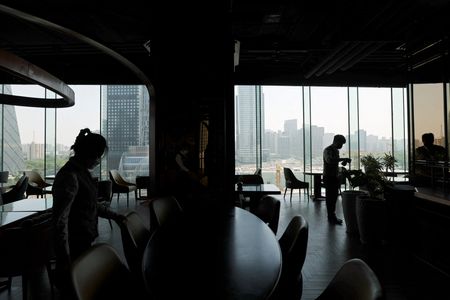
BEIJING (Reuters) – China’s services activity contracted for a third straight month in May, pointing to a slow recovery ahead despite the easing of some COVID lockdowns in Shanghai and neighbouring cities, a private business survey showed on Monday.
The Caixin services purchasing managers’ index (PMI) rose to 41.4 in May from 36.2 in April, edging up slightly as authorities began to roll back some of the strict restrictions that have paralysed the financial city of Shanghai and roiled global supply chains.
However, the reading remained well below the 50-point mark that separates growth from contraction on a monthly basis.
Analysts say weakness in the services sector, which accounts for about 60% of China’s economy and half of urban jobs, is likely to persist under the government’s zero-COVID policy, with contact-intensive sectors such as hotels and restaurants bearing the brunt of the fallout.
An official survey on Tuesday also showed the services sector was still mired in contraction.
The Caixin survey showed new business, including new export orders, fell for the fourth straight month in May as restrictions on mobility kept customers at home and disrupted operations.
That led services firms to reduce their payrolls at a sharper rate, with a sub-index for employment standing at 48.5, the lowest since February last year and down from 49.3 the previous month.
Official data showed China’s nationwide survey-based jobless rate had climbed to 6.1% in April, the highest since February 2020 and well above the government’s 2022 target of below 5.5%.
“The employment measure has remained in contractionary territory since the beginning of this year. The impact of the epidemic has hit the labour market. Enterprises weren’t much motivated to increase hiring. As a result, outstanding business (backlogs) in the services sector grew further,” said Wang Zhe, Senior Economist at Caixin Insight Group.
China’s economic activity cooled sharply in April as the country grappled with the worst COVID-19 outbreak since 2020.
To stabilise the situation in a politically sensitive year, China’s cabinet recently announced a package of 33 measures covering fiscal, financial, investment and industrial policies, although analysts say the official GDP target of around 5.5% will be hard to achieve without easing the zero-COVID strategy.
“It’s necessary for policymakers to pay closer attention to employment and logistics. Removing obstacles in supply and industrial chains and promoting resumption of work and production will help to stabilize market entities and protect the labour market,” said Wang from Caixin Insight Group, adding that they should also hand out subsidies for people whose income have been affected by COVID.
Caixin’s May composite PMI, which includes both manufacturing and services activity, rose to 42.2 from 37.2 the previous month. Factory activity shrank less sharply in May but still posted the second largest slump since February 2020, suggesting a recovery remains fragile.
The Caixin PMI is compiled by S&P Global from responses to questionnaires sent to purchasing managers in China.
(Reporting by Stella Qiu and Ryan Woo; Editing by Kim Coghill)

